Q4. Charge q₁ = 2.0 nC is located at (0, 0) and charge q2 = -4.0 nC is located at (-3.0 cm, 0). a) Sketch a diagram of the charge distribution. b) What is the electric potential at point A (2.0 cm,0)? c) What is the electric potential at point B (3.0 cm, 0)? d) What is the change of electric potential from A to B?
Q4. Charge q₁ = 2.0 nC is located at (0, 0) and charge q2 = -4.0 nC is located at (-3.0 cm, 0). a) Sketch a diagram of the charge distribution. b) What is the electric potential at point A (2.0 cm,0)? c) What is the electric potential at point B (3.0 cm, 0)? d) What is the change of electric potential from A to B?
College Physics
11th Edition
ISBN:9781305952300
Author:Raymond A. Serway, Chris Vuille
Publisher:Raymond A. Serway, Chris Vuille
Chapter16: Electrical Energy And Capacitance
Section: Chapter Questions
Problem 18P: A positive point charge q = +2.50 nC is located at x = 1.20 m and a negative charge of 2q = 5.00 nC...
Related questions
Question
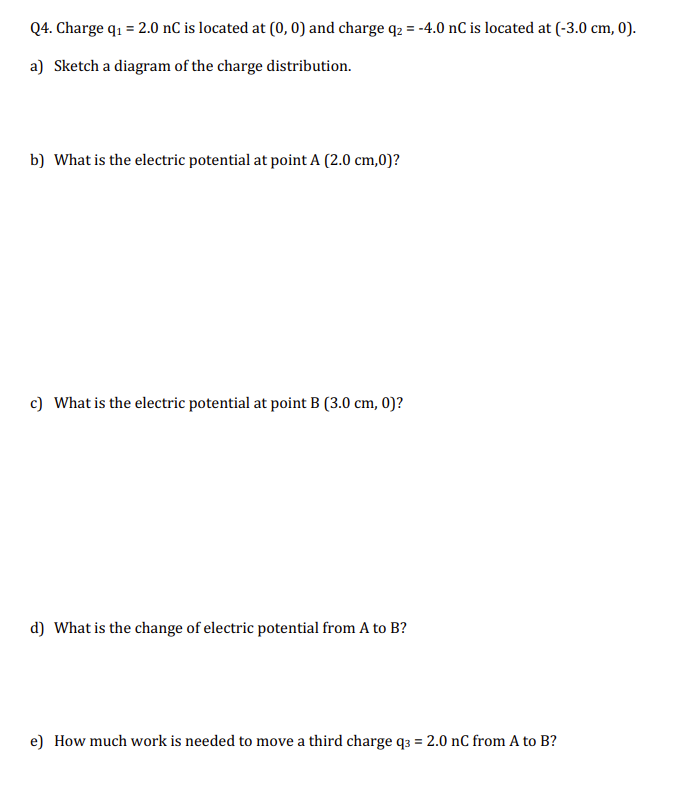
Transcribed Image Text:Q4. Charge q₁ = 2.0 nC is located at (0, 0) and charge q₂ = -4.0 nC is located at (-3.0 cm, 0).
a) Sketch a diagram of the charge distribution.
b) What is the electric potential at point A (2.0 cm,0)?
c) What is the electric potential at point B (3.0 cm, 0)?
d) What is the change of electric potential from A to B?
e) How much work is needed to move a third charge q3 = 2.0 nC from A to B?
Expert Solution
This question has been solved!
Explore an expertly crafted, step-by-step solution for a thorough understanding of key concepts.
Step by step
Solved in 5 steps with 2 images

Knowledge Booster
Learn more about
Need a deep-dive on the concept behind this application? Look no further. Learn more about this topic, physics and related others by exploring similar questions and additional content below.Recommended textbooks for you
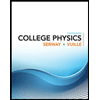
College Physics
Physics
ISBN:
9781305952300
Author:
Raymond A. Serway, Chris Vuille
Publisher:
Cengage Learning
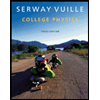
College Physics
Physics
ISBN:
9781285737027
Author:
Raymond A. Serway, Chris Vuille
Publisher:
Cengage Learning

Physics for Scientists and Engineers, Technology …
Physics
ISBN:
9781305116399
Author:
Raymond A. Serway, John W. Jewett
Publisher:
Cengage Learning

College Physics
Physics
ISBN:
9781305952300
Author:
Raymond A. Serway, Chris Vuille
Publisher:
Cengage Learning

College Physics
Physics
ISBN:
9781285737027
Author:
Raymond A. Serway, Chris Vuille
Publisher:
Cengage Learning

Physics for Scientists and Engineers, Technology …
Physics
ISBN:
9781305116399
Author:
Raymond A. Serway, John W. Jewett
Publisher:
Cengage Learning
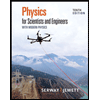
Physics for Scientists and Engineers with Modern …
Physics
ISBN:
9781337553292
Author:
Raymond A. Serway, John W. Jewett
Publisher:
Cengage Learning

Principles of Physics: A Calculus-Based Text
Physics
ISBN:
9781133104261
Author:
Raymond A. Serway, John W. Jewett
Publisher:
Cengage Learning
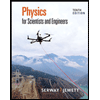
Physics for Scientists and Engineers
Physics
ISBN:
9781337553278
Author:
Raymond A. Serway, John W. Jewett
Publisher:
Cengage Learning